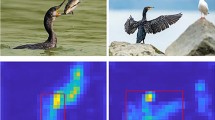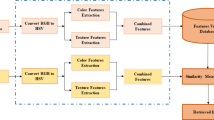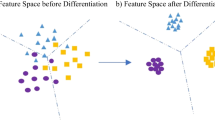Abstract
Simulating primates’ ability to make fine visual discriminations for extracting visual features remains a challenge. To address this issue, a novel method was proposed, which was named the object semantic aggregation histogram. By using the developed method, the mid-level object features and high-level semantic features can be aggregated into a discriminative compact representation for image retrieval. The proposed method includes three main highlights: (1) two adaptive semantic kernels were proposed to bridge the object features and semantic features. It can serve as a connecting link for detailed object representation. (2) Both object and semantic features were aggregated to provide a discriminative representation by depicting the target objects, semantic cognition, and spatial layouts. This approach is consistent with the coarse-to-fine nature of perception in the visual hierarchy. (3) A simple yet generic method was introduced to implement dimensionality reduction and whitening. It can provide a good choice of using various regularizations to decide optimal compact representation. Experiments on benchmark datasets confirmed that the proposed method can effectively improve the retrieval performance in terms of mAP. The mAPs of the proposed method using 128-dimensionality representation were significantly greater than that of the CroW, SBA, DSFH, and DTFH methods by 0.042, 0.035, 0.061, and 0.029 on the Oxford5k dataset and by 0.019, 0.017, 0.083, and 0.034 on the Holidays dataset. The proposed method is regarded as an effective and competitive method of aggregating multiple visual hierarchy features, while no complex handcrafting or training is required.







Similar content being viewed by others
Data Availability
The author has used third-party data and therefore does not own the data, and those benchmark datasets are public. The code of the proposed method is available on request.
References
Li X, Yang J, Ma J. Recent developments of content-based image retrieval (CBIR). Neurocomputing. 2021;452:675–89.
Kalantidis Y, Mellina C, Osindero S. Cross-dimensional weighting for aggregated deep convolutional features. Proc Eur Conf Comput Vis. 2016;685–701.
Zhu J, Wang J, Pang S, Guan W, Li Z, Li Y, et al. Co-weighting semantic convolutional features for object retrieval. J Vis Commun Image Represent. 2019;62:368–80.
Xu J, Wang C, Qi C, Shi C, Xiao B. Unsupervised semantic-based aggregation of deep convolutional features. IEEE Trans Image Process. 2019;28(2):601–11.
Lu F, Liu G-H. Image retrieval using contrastive weight aggregation histograms. Digit Signal Process. 2022;123:103457.
Lu Y, Yin J, Chen Z, Gong H, Liu Y, Wang W, et al. Revealing detail along the visual hierarchy: neural clustering preserves acuity from V1 to V4. Neuron. 2018;98(2):417–28.
Zhou Y, Zeng F-Z, Zhao H-M, et al. Hierarchical visual perception and two-dimensional compressive sensing for effective content-based color image retrieval. Cogn Comput. 2016;8:877–89.
Krizhevsky A, Sutskever I, Hinton G.E. ImageNet classification with deep convolutional neural networks. Proc Int Conf Neural Inf Process Syst. 2012;1097–105.
Simonyan K, Zisserman A. Very deep convolutional networks for large-scale image recognition. Proc Int Conf Learn Represent. San Diego, CA. 2015.
He K, Zhang X, Ren S, Sun J. Deep residual learning for image recognition. Proc IEEE Conf Comput Vis Pattern Recognit. 2016;770–78.
Sandler M, Howard A, Zhu M, Zhmoginov A, Chen L-C. MobileNetV2: inverted residuals and linear bottlenecks. Proc IEEE/CVF Conf Comput Vis Pattern Recognit. 2018;4510–20.
Forcén JI, Pagola M, Barrenechea E, Bustince H. Co-occurrence of deep convolutional features for image search. Image Vis Comput. 2020;97(5):103909.
Zhang B, Wang Q, Lu X, Wang F, Li P. Locality-constrained affine subspace coding for image classification and retrieval. Pattern Recognit. 2020;100:107167.
Bai C, Li H, Zhang J, Huang L, Zhang L. Unsupervised adversarial instance-level image retrieval. IEEE Trans Multimedia. 2021;23:2199–207.
Chen B, Wu Z, Davis L, Lim S. Efficient object embedding for spliced image retrieval. Proc IEEE/CVF Conf Comput Vis Pattern Recognit. 2021;14960–70.
Zhang B-J, Liu G-H, Hu J-K. Filtering deep convolutional features for image retrieval. Int J Pattern Recognit Artif Intell. 2022;36(01):2252003.
Li Y, Kong X, Zheng L, Tian Q. Exploiting hierarchical activations of neural network for image retrieval. Proc ACM Int Conf Multimedia. 2016;132–36.
Liu G-H, Yang J-Y. Deep-seated features histogram: a novel image retrieval method. Pattern Recognit. 2021;116:107926.
Liu G-H, Yang J-Y. Exploiting deep textures for image retrieval. Int J Mach Learn Cybern. 2023;14(2):483–94.
Jia X, Siegle JH, Durand S, Heller G, Ramirez T, Koch C, et al. Multi-regional module-based signal transmission in mouse visual cortex. Neuron. 2022;110(9):1585–98.E9.
UFLDL Tutorial. PCA Whitening. http://ufldl.stanford.edu/tutorial/unsupervised/PCAWhitening/. Accessed 25 Sep 2022.
Philbin J, Chum O, Isard M, Sivic J, Zisserman A. Object retrieval with large vocabularies and fast spatial matching. Proc IEEE Conf Comput Vis Pattern Recognit. 2007;1–8.
Philbin J, Chum O, Isard M, Sivic J, Zisserman A. Lost in quantization: improving particular object retrieval in large scale image databases. Proc IEEE Conf Comput Vis Pattern Recognit. 2008;1–8.
Radenovic F, Iscen A, Tolias G, Avrithis Y, Chum O. Revisiting Oxford and Paris: large-scale image retrieval benchmarking. Proc IEEE/CVF Conf Comput Vis Pattern Recognit. 2018;5706–15.
Jégou H, Douze M, Schmid C. Hamming embedding and weak geometric consistency for large scale image search. Proc Eur Conf Comput Vis. 2008;304–17.
Funding
This work was supported in part by the National Natural Science Foundation of China (grant no. 62266008), the Foundation of Guangxi Normal University (grant no. 2021JC007), and the Foundation of Development Research Centre of Guangxi in Humanities and Social Sciences (grant no. ZXZJ202201).
Author information
Authors and Affiliations
Contributions
Fen Lu: conceptualization; software; validation; writing, original draft; resources; and data curation. Guang-Hai Liu: methodology, review and editing, supervision, revision, funding acquisition, and formal analysis.
Corresponding author
Ethics declarations
Conflict of Interest
The authors declare no competing interests.
Additional information
Publisher's Note
Springer Nature remains neutral with regard to jurisdictional claims in published maps and institutional affiliations.
Rights and permissions
Springer Nature or its licensor (e.g. a society or other partner) holds exclusive rights to this article under a publishing agreement with the author(s) or other rightsholder(s); author self-archiving of the accepted manuscript version of this article is solely governed by the terms of such publishing agreement and applicable law.
About this article
Cite this article
Lu, F., Liu, GH. Image Retrieval Using Object Semantic Aggregation Histogram. Cogn Comput 15, 1736–1747 (2023). https://doi.org/10.1007/s12559-023-10143-6
Received:
Accepted:
Published:
Issue Date:
DOI: https://doi.org/10.1007/s12559-023-10143-6




